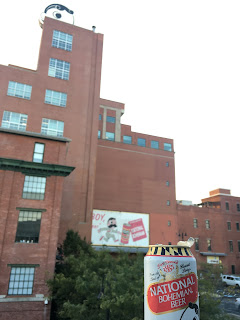 |
| Rosemont Station area |
Baltimore City will develop and fund a Red Line neighborhood investment strategy to enhance the quality of life in Red Line station communities, including:An example of possible development near a planned station was recently explored by the BBJ’s Melody Simmons: The East Baltimore Crown and Cork factory campus sitting right on the seam of Highlandtown and Greektown, two neighborhoods highly separated by freight rail and the campus itself. The strategic importance of this area had long been identified by various community working groups including the Station Area Advisory Committee which worked for 18 months on visions for their station area. Connecting Highlandtown and Greektown and creating better walk access between the communities by making it easier to traverse the barriers of the existing freight rail lines remains a necessity. The 30 acre property is currently for sale.
- Work with local foundations and other partners to create a public-private entity similar to Atlanta’s “BeltLine Partnership” to raise funds and mobilize resources towards community revitalization on the scale of Baltimore’s commitment to the East Baltimore Development, Inc., Park Heights Development Authority and the Westside Renaissance.
- Implement non-traditional funding strategies for public/private partnerships to stimulate growth and development for Red Line station communities in order to achieve public amenities which may not normally be considered part and parcel of Red Line project costs.
- Evolve Station Area Advisory Committees into Community Development Corporations (CDCs), as appropriate. Provide new CDCs and existing community-based development organizations with resources to build capacity and strength to achieve revitalization plans.(From the Red Line Community Compact)
Vacancy concentrations in Baltimore
 |
| TOD sketch for Highlandtown station with Crown Cork and Seal area to the right |
On the west-side of the former Red Line corridor the needs are even more immediate. Large swaths of dense urban development between Edmondson Village and downtown remain largely without services and retail. They form a large "food desert" where many people live in food insecurity. It is high time to revisit the east-west corridor cutting right through one of the wings of Baltimore's "black butterfly" known as Route 40, which is also famous for the destruction of a good portion of West Baltimore when the "highway to nowhere" was built.
In post-Freddie Gray and post-uprising Baltimore the city is big on good intentions and small on delivery of projects which target the inequities that fueled the unrest. Aside from a few projects such as the renovated Western Police Station, a new playground at the Harlem Park Daycare and the renovated Sarah's Hope women center, West Baltimore has not seen the type of systemic transformation that can only come from strategic stepping-stone investment in targeted areas. There is no need to go out and query the residents what they want. They have already spoken. Their ideas and visions with specific plans and programs for Edmondson Village, Rosemont, West Baltimore and Harlem Park are embedded in the plans now dusting away on some shelf. Attempts to soften the impact of the sunken freeway need a new spark.
 |
| Poverty in station areas: Highest at Park Heights Station (40%) |
How hard it is to attract and keep services and retail in disinvested communities can be studies at Mondawmin where Target announced its departure this month, even though the store has a vast and dense catchment area and excellent transit access. There is even significant nearby investment on the Coppin University campus.
The Mondawmin example doesn't prove that it is impossible to keep vibrant service centers in communities with below average income. Instead, it shows that the efforts of stabilizing the surrounding communities have been too tepid. Reinvestment in the residential blocks around Mondawmin has been so slow and halting, even though the area is close to transit and Druid Heights Park that nobody would identify the Mondawmin area as a renaissance area.
The situation around the West Baltimore MARC station is worse. In spite of MTA's investment in rail station upgrades and a new bus transit center, the surrounding commercial, residential and formerly industrial areas remain as blighted as ever, most prominent among them the former "Ice House" which presides as a half fallen ruin over the transit plaza. The sorry sight signals to anybody coming into Baltimore from DC that nobody cares about the area enough to even prop up the facility cosmetically.
 |
| Rosemont and West Baltimore vision plans prepared by station area advisory goups |
Just to the west, Rosemont looks even more desperate. It too has strong assets nearby. The community sits only a stone through from the Gwynns Falls valley and park which is one of the best wilderness areas right inside a city near and far.
Mayor Pugh has spoken about community land trusts, social investment funds and similar methods of capitalizing investment in neighborhoods. Examples of coordinated and orchestrated strategic investments can be found in east Baltimore where efforts are underway of transforming entire swaths of disinvested areas from Oliver to Johnston Square and from Gay Street to EBDI. It is time that similar efforts get underway in Freddy Gray's West Baltimore. The Red Line corridor is the canvas and the SAAC plans the ideas. Let's get it started.
Klaus Philipsen, FAIA
BBJ article about Crown, Cork and Seal property in Highlandtown
Crown Industrial Park
Planning Department Red Line TOD archive
Equitable Transit Oriented Development in Baltimore. Enterprise Community Partners
I made a similar point on this blog on 9/17/2015:
The reverse approach to transit: TOD first.

































